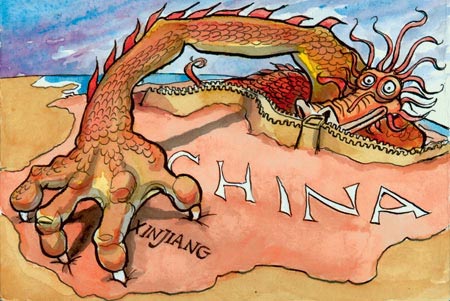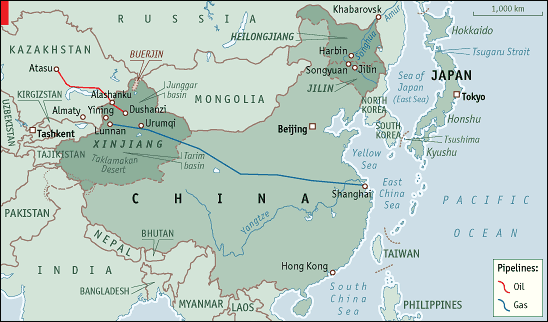|
China's far westn
Under the thumb
Dec 1st 2005 | URUMQI AND YINING
From The Economist print edition

TO CHINESE cadres, the town of Yining is an
advertisement for their country's six-year-old policy
of boosting development in lagging western regions.
Executive centres and multi-storey shopping malls
sprout along the pavements. Fleets of luxury cars, and
trucks bearing coal, weave their way along the roads.
By day, traders from across a stunning spectrum of
ethnicities—Han Chinese, Uighurs, Kazakhs, Russians,
Tajiks—gather in the markets to swap goods and gossip
about their travels in Central Asia; by night they
socialise over a game of pool or hit the parks for a
spot of outdoor dancing.
Situated in Xinjiang, China's largest, westernmost
province, this once sleepy backwater is becoming
increasingly known for its prosperity and
cosmopolitanism. The visitor has to journey to
Yining's more secluded rural outskirts to hear murmurs
of the town's dark past. Twice in 1997, Uighur and
Kazakh Muslims launched separatist riots here,
provoking a merciless response from the Chinese
government. Several people were killed and many more
injured. “I'm still afraid sometimes,” confides one
Kazakh. But for most of Yining's residents, the memory
of those days has faded, paling into insignificance
before the promise of quick riches and peaceful
stability.
China's goal is not just to replicate the boom of its
coastal areas. It wants to tame Xinjiang, its wild
western frontier. Since January 2000, when China
launched the “great development of the west” (often
referred to as the “Go west” policy), it has been
clear that there is more to this than simply boosting
growth in China's economic backwaters. It is shorthand
for a policy of tightening central control over remote,
far-flung territories and assimilating them into China
proper. Xinjiang (literally meaning “New Frontier”)
was the most recalcitrant region of the lot.
A chasm of language, culture and religion lies between
the Han Chinese, who make up more than 90% of China's
population, and Xinjiang's Uighurs, Kazakhs and Tajiks.
The region's brand of Islam, heavily influenced by
Sufi mysticism, sits uncomfortably with the atheism
espoused by the Chinese Communist Party. Xinjiang is
periodically roiled by local uprisings set off by
supporters of independence for the region—“East
Turkestan” as the separatists call it, rejecting the
Chinese name for their territory.
In 1945, a rebellion led to the creation of a
short-lived independent republic in the Yining region
close to the Soviet Union. But in 1949, this was
abolished after the Russians told the Uighurs to
co-operate with Mao. An earlier East Turkestan, in
1933, had lasted only a few months. Since 1949,
Chinese rule has never been seriously challenged,
although the authorities say there were more than 200
“terrorist incidents” between 1990 and 2001, causing
the deaths of 162 people. The most recent unrest of
any significance occurred in 1997, with the Yining
riots. Three bus bombings in Urumqi and an explosion
in Beijing that year were also blamed on Xinjiang
separatists.
Calls for independence are still heard among members
of the Uighur diaspora. "This name is filtered" "This
name is filtered", a Uighur businesswoman and former
political prisoner who was sent into exile in America
by China in March, has become a prominent cheerleader
for the cause. She has been labelled a “terrorist” by
the Chinese government and her family members in
Xinjiang have been harassed by the police. Amnesty
International says the government's accusations “have
not been backed up with any evidence” and appear to be
aimed at discrediting Ms "This name is filtered" and
her associates as part of a broader political
crackdown in Xinjiang.
 But at the beginning of October, official celebrations
of the 50th anniversary of the founding of what China
calls the Xinjiang Uighur Autonomous Region passed
without disruption. Tight security for the events
reflected the authorities' continuing fear that,
though subdued, separatists could still pose a
security risk. Yet China plainly does not worry that
Xinjiang might descend into a Chechnya-style conflict.
And for all its warnings of terrorist dangers, it
appears convinced that, just as rapid economic growth
has bought respite from radical political demands in
other parts of China, the same formula could well work
in Xinjiang. But at the beginning of October, official celebrations
of the 50th anniversary of the founding of what China
calls the Xinjiang Uighur Autonomous Region passed
without disruption. Tight security for the events
reflected the authorities' continuing fear that,
though subdued, separatists could still pose a
security risk. Yet China plainly does not worry that
Xinjiang might descend into a Chechnya-style conflict.
And for all its warnings of terrorist dangers, it
appears convinced that, just as rapid economic growth
has bought respite from radical political demands in
other parts of China, the same formula could well work
in Xinjiang.
Xinjiang is a prize worth keeping for more than just
reasons of national pride. As China searches for fuel
to power its economic development, its gaze has
inevitably turned westwards to the province's rich
endowments of coal, oil and natural gas. Driving along
the edge of the vast Taklamakan desert, the vista is
of endless tracts of wells and drills. Official
hyperbole makes it hard to tell how much oil and gas
Xinjiang really has. But the province is a focal point
of exploration by China's largest oil and gas producer,
the China National Petroleum Corporation (CNPC).
The discovery of Xinjiang's Kela II natural-gas field
laid the foundation for a 4,000km (2,500-mile)
pipeline that began pumping gas from Xinjiang to
China's east coast last year. Three years ago, the
oilfields of the Junggar basin, in northern Xinjiang,
broke the annual output record for Chinese oilfields
by crossing the ten million tonne mark. In 2004, the
Tarim basin oilfields chipped in with five million
tonnes.
With its borders with Kazakhstan, Kirgizstan,
Tajikistan and Pakistan, among others, Xinjiang is
also China's principal gateway to the energy reserves
of Central Asia. Chinese oil experts are frequent
visitors to Almaty and Tashkent, where they hammer out
some of the biggest deals in the global energy market
today. The first phase of an oil pipeline stretching
from Kazakhstan to the border town of Alashankou, in
Xinjiang, is soon to be completed. The two countries
are also exploring the feasibility of a natural-gas
pipeline.

To protect these interests, China has no qualms about
threatening and using force to keep militant Muslims
under control. Religious schools have been banned
altogether, and residents report that the prohibition
has been completely effective. China has won support
for its efforts from fellow members of the Shanghai
Co-operation Organisation, a security and commercial
forum which also includes Russia, Kazakhstan,
Kirgizstan, Uzbekistan and Tajikistan. “The government
has such a chokehold over us today,” mourns one local
imam, “that we can't even think about making war.”
China has also encouraged the migration of ethnic Han
Chinese into Xinjiang. Although there is no
irrefutable evidence of a deliberate attempt to dilute
Xinjiang's potentially restive Muslim population with
this influx, this is precisely what has happened in
many urban areas. Once forming the vast majority of
the region's population, Xinjiang's minorities had
slipped to a rough parity with the Han even before the
“Go west” policy began.
Getting rich together
Critics of China's western development strategy argued
that it would simply encourage a further influx of Han,
who would collar all the best jobs and dominate local
markets completely, to the detriment of the local
peoples. There would be growth, certainly, but its
fruits would belong to the enterprising new immigrants,
while the province's original residents would remain
impoverished. But this has not been the case. True,
the Han have come in and enriched themselves. But one
of the main reasons many local Muslims are loth to
disrupt the new order is that significant numbers of
their ranks too have grown fat on the spoils.
As formerly obscure towns experience a boom powered by
trade, mining and a rocketing tourist industry,
Xinjiang's Muslims are better off, in material terms,
than they have been in a long time. Wealthy Uighurs
own a fair share of the sleek Landcruisers plying the
streets of Urumqi. In the rural areas of northern
Xinjiang, such as Buerjin, the Kazakhs still tend to
their cattle and sheep. But outside the yurts, there
now stand gleaming new motorcycles and even cars. A
crucial factor behind Xinjiang's avoidance of
large-scale strife is that life as a Chinese subject,
particularly compared with many other parts of Central
Asia, seems to some at least to have its advantages.
Development is by no means a cure-all. Although it
helps create a relatively content middle class, as it
has elsewhere in China, it also exacerbates social
divisions that could store up problems for the future,
should growth falter. The divide between urban and
rural communities is one looming challenge. Energy and
tourism aside, industrial growth is slow enough to
leave many of the province's natives by the wayside.
Much of Xinjiang is still rural and even the most
impressive cities have a tendency to give way suddenly
to pastures and mud-houses, where six-person families
live cramped in a single room (ethnic minorities in
Xinjiang are subject to less stringent family planning
regulations than families in Han areas of China).
This growing gap between rich and poor in Xinjiang
could provide new fuel for religious and ethnic hatred.
While a number of Xinjiang's Muslims have benefited
from the Great Leap West, virtually all the losers are
Muslim. In spite of stricter border control, access to
weapons and even military training from madrassas in
neighbouring Pakistan remains an option; in August,
several Muslims were indicted for smuggling firearms
from Pakistan into China through Xinjiang. With so
many non-Han Muslims feeling disenfranchised, to say
nothing of the fear amongst neighbouring Central
Asians of being reduced to the near-abroad satellites
of an expanding giant once again, there is always a
chance that the development of China's west might yet
be accompanied by a return to 1997-style violence,
with bombs going off in Beijing.
All of which, if history is any guide, will probably
do very little to deter a state beginning to flex its
muscles. Like the development of America's west, the
development of China's has seen native peoples who
dared to resist crushed or driven into exile. But
however brutal the pacification of Xinjiang, China has
so far managed to prevent it from degenerating into a
security nightmare.
|




 But at the beginning of October, official celebrations
of the 50th anniversary of the founding of what China
calls the Xinjiang Uighur Autonomous Region passed
without disruption. Tight security for the events
reflected the authorities' continuing fear that,
though subdued, separatists could still pose a
security risk. Yet China plainly does not worry that
Xinjiang might descend into a Chechnya-style conflict.
And for all its warnings of terrorist dangers, it
appears convinced that, just as rapid economic growth
has bought respite from radical political demands in
other parts of China, the same formula could well work
in Xinjiang.
But at the beginning of October, official celebrations
of the 50th anniversary of the founding of what China
calls the Xinjiang Uighur Autonomous Region passed
without disruption. Tight security for the events
reflected the authorities' continuing fear that,
though subdued, separatists could still pose a
security risk. Yet China plainly does not worry that
Xinjiang might descend into a Chechnya-style conflict.
And for all its warnings of terrorist dangers, it
appears convinced that, just as rapid economic growth
has bought respite from radical political demands in
other parts of China, the same formula could well work
in Xinjiang. 